
Criminals have found a brazen new way to drain your bank account that goes far beyond the usual fake text messages. They're now orchestrating elaborate schemes that involve both digital deception and old-fashioned porch piracy, creating a one-two punch that's catching even cautious consumers off guard.
The numbers tell a concerning story for anyone with a debit card.
Debit card fraud accounted for 39% of fraud losses at financial institutions in 2024, making it the top driver of fraud losses—significantly outpacing credit card fraud, which only accounted for 5% of losses.
For Americans over 60, the stakes are particularly high: individuals aged 60–69 reported the largest total fraud losses in 2024, reaching $1.18 billion.
What makes this new scam particularly insidious is how it combines digital manipulation with physical theft, creating multiple opportunities for criminals to succeed even when victims become suspicious.
How the porch piracy debit card scam works
The scheme starts with a familiar approach—a fraudulent call or text claiming to be from your bank.
The scammer informs you that your account has been compromised and that you need to act quickly.
So far, this sounds like countless other bank impersonation scams you've probably heard about.
But here's where it gets more sophisticated: the criminals aren't just after your account information.
They're specifically trying to trigger your bank to send you a replacement debit card, which they then plan to steal right from your mailbox or front porch.
Mail theft has become one of the top fraud vectors
Once you've been convinced to request a new card or your bank has automatically sent one due to reported suspicious activity, the criminals shift into phase two.
They monitor your address—information they may have obtained through data breaches, social media, or previous scams—and watch for package deliveries.
In September, Troy, Michigan police arrested David Andrew Williams in connection with exactly this type of scheme.
According to police, Williams was caught attempting to steal a package containing a new debit card from a customer's porch after investigators had set up surveillance.
The final step is the most damaging: armed with your new debit card and potentially some personal information they've gathered, the criminals can drain your bank accounts through ATM withdrawals or purchases.
This often happens before you even realize the card has been stolen.
Also read: How a Richmond scam exposed new dangers for older Americans
Why seniors are prime targets
While anyone can fall victim to fraud, seniors face unique vulnerabilities in these schemes.
Although seniors lose money to fraud in only 24% of cases compared to 44% for adults aged 20–29, when seniors do lose money to fraud, they have much higher loss rates than young adults.
This pattern reflects both the financial reality—many seniors have accumulated more savings over their lifetimes—and behavioral factors.
Seniors may be more likely to trust authority figures and less familiar with digital warning signs that might alert younger victims.
Why debit cards are riskier than credit cards
Unlike credit cards, debit cards are directly connected to your bank account. When fraudsters use your debit card, they're taking your actual money immediately, not just creating charges you can dispute later. This makes recovery more difficult and the impact more immediate.
Additionally, email has become the most common method fraudsters use to contact victims in 2024, followed by phone calls and text messages.
Many seniors receive numerous legitimate communications from their banks via these channels, making it harder to distinguish between real and fraudulent messages.
Source: Facebook / Troy Police Department - Troy, Michigan
Also read: Wisconsin Rapids scam costs resident $600,000: What seniors should know
The chip card twist that's fooling victims
Another variation of this scam involves criminals convincing victims to destroy their current debit card but leave the chip intact.
According to an FBI alert, scammers pose as bank employees and tell customers that fraudulent activity has been detected on their account.
The victims are then instructed to cut up their debit card but preserve the small computer chip 'for security reasons.'
The fake bank employee arranges for an accomplice to pick up the chip from the victim's home, claiming it needs to be returned to the bank for processing.
Once criminals have both the chip and your PIN number—which they obtain through social engineering during the phone call—they can create a new card and access your account.
Also read:1.8 billion iPhone users warned of fast-growing bank account scam
Warning signs that should make you hang up immediately
Recognizing these scams early is your best defense.
Here are the warning signs that should immediately make you suspicious:
- Any caller claiming to be from your bank asking for your PIN, password, or one-time security codes
- Pressure to act immediately to "secure" your account
- Instructions to cut up your card but save the chip
- Requests to confirm personal information they should already have
- Offers to send someone to your home to collect anything bank-related
Essential protection steps for debit card security
- Never give personal banking information over the phone, even if the caller seems legitimate
- If someone claims to be from your bank, hang up and call the number on your card or statement
- Consider having packages delivered to a secure location if you're frequently away from home
- Monitor your accounts daily for unauthorized transactions
- Report suspicious activity immediately to limit your liability
Also read: How one scam drained a senior’s savings—and what you can do to stay safe
What to do if you've been targeted
If you suspect you've been contacted by scammers or noticed suspicious activity on your accounts, act quickly:
Immediate steps:
- Contact your bank immediately using the phone number on your card or statement
- Change your online banking passwords and PINs
- Monitor your accounts closely for several weeks
- Consider placing a fraud alert on your credit reports
For stolen cards or packages:
- Report the theft to both your bank and local police
- File a complaint with the FBI's Internet Crime Complaint Center at ic3.gov
- Keep detailed records of all communications and transactions
Also read: She lost $57,000 in one day: How a phone scam targeted a woman in Oregon
Your legal protections
Federal law provides some protection for debit card fraud, but the timeline matters significantly.
If you report a lost or stolen debit card within two business days of discovering the problem, your liability is limited to $50.
However, if you wait longer, you could be responsible for up to $500 in fraudulent charges.
Did you know?
Did you know?
The Electronic Fund Transfer Act provides stronger protections than many people realize. You're never liable for the first unauthorized charge—only for subsequent charges that could have been prevented if you had reported the theft quickly.
Unlike credit card fraud, where federal law caps your liability at $50 regardless of timing, debit card protections require prompt reporting. This makes daily account monitoring essential for anyone with a debit card.
Also read: The “astronaut scam” that cost one woman thousands—and what you can learn from it
The technology gap criminals exploit
Modern chip technology has significantly reduced in-person fraud, but it's created new opportunities for creative criminals.
Credit card fraud cases reported to the FTC in the first half of 2025 reached 323,459, representing a 51% increase year over year, showing that fraudsters are adapting faster than security measures can keep up.
Banks have invested heavily in fraud detection systems, but these technological advances sometimes work against consumers in unexpected ways.
Automated systems may flag legitimate transactions as suspicious, leading to cards being canceled and replacement cards being sent—creating opportunities for mail theft.
Also read: Unwanted medical gear at your door? It could be a dangerous Medicare scam
Banking industry response
The financial industry recognizes the growing threat.
Scott Anchin from the Independent Community Bankers of America notes that at some community banks, fraud losses now exceed traditional loan losses.
This has prompted banks to increase their investment in customer education and fraud prevention.
Many banks have started sending fraud alerts via multiple channels and requiring additional verification for card replacement requests.
However, criminals continue to adapt, finding new ways to exploit both technological systems and human psychology.
Simple steps for better protection
Protecting yourself doesn't require becoming a technology expert. These straightforward strategies can significantly reduce your risk:
For your mail and packages:
- Consider using your bank's branch locations for card pickup when possible
- Install a locking mailbox or use a post office box for sensitive mail
- Have packages delivered to your workplace or ask neighbors to collect them when you're away
- Sign up for delivery notifications from UPS, FedEx, and the Postal Service
For digital communications:
- Never respond to urgent requests for banking information via email or text
- When in doubt, visit your bank branch in person to verify any concerning communications
- Use your bank's official app or website rather than clicking links in messages
Also read: Former postal fraud investigator accused of stealing $330,000 from scam victims
Moving forward with confidence
While these evolving fraud schemes can seem overwhelming, remember that awareness is your best defense.
The youngest and oldest Americans report the fewest cases of identity theft, which may suggest that they simply opt not to report, aren't aware that they can, or don't know how.
By understanding how these scams work and taking basic precautions, you can continue to use your debit card safely while staying alert to new threats.
The key is maintaining healthy skepticism about unsolicited communications while staying informed about your account activity.
The criminals behind these schemes are counting on confusion, urgency, and trust in authority figures.
By slowing down, verifying information independently, and never providing sensitive information over the phone, you can protect yourself from becoming another statistic in this growing problem.
Banks will never ask you to provide PINs, passwords, or security codes over the phone.
When someone does, that's your signal to hang up and call your bank directly.
Taking that extra step could save you thousands of dollars and months of financial recovery.
Read next:
- Falling for the “transfer it to protect it” scam? FTC warns this scheme is targeting older Americans
- TSA PreCheck scam warning: Travelers urged to watch for fake renewal websites
- Got a text about an Amazon refund? Don’t click—it’s a scam
What experiences have you had with suspicious banking communications? Have you noticed an increase in fraud attempts in your area? Share your thoughts and help other readers stay informed about emerging scams.
Primary Source
https://www.usatoday.com/story/money/personalfinance/2025/10/08/debit-and-atm-card-scam/86589382007/
Fed survey: Most fraud losses attributable to debit card, check fraud | ABA Banking Journal
Cited text: However, debit card fraud accounted for 39% of fraud losses last year, followed by check fraud at 30%.
Excerpt: Debit card fraud accounted for 39% of fraud losses at financial institutions in 2024, making it the top driver of fraud losses
https://bankingjournal.aba.com/2025...osses-attributable-to-debit-card-check-fraud/
Credit Card Fraud Statistics for 2025
Cited text: (Source: Consumer Sentinel Network, Annual Reports) Individuals aged 60-69 reported the largest total loss in 2024 ($1,180 million), while those aged ...
Excerpt: individuals aged 60-69 reported the largest total fraud losses in 2024, reaching $1.18 billion
https://wallethub.com/edu/cc/credit-card-fraud-statistics/25725
Fraud Prevention Facts and Statistics | VA, MD & DC ⋆ John Marshall Bank
Cited text: These fraud facts showed that 44% of adults age 20-29 who have reported fraud, end up losing money in a fraud case, compared to only 24% of seniors. H...
Excerpt: Although seniors lose money to fraud in only 24% of cases compared to 44% for adults aged 20-29, when seniors do lose money to fraud, they have much higher loss rates than young adults
https://www.johnmarshallbank.com/resources/security-center/fraud-facts-and-statistics/
22 credit card fraud statistics for 2025
Cited text: Email was the most common method of contact used by fraudsters in 2024, followed by phone calls and text messages.1 · 11.
Excerpt: email has become the most common method fraudsters use to contact victims in 2024, followed by phone calls and text messages
https://lifelock.norton.com/learn/credit-finance/credit-card-fraud-statistics
Identity Theft and Credit Card Fraud Statistics for 2025 | The Motley Fool
Cited text: 323,459 cases of credit card fraud were reported to the FTC in the first half of 2025, a 51% increase year over year.
Excerpt: Credit card fraud cases reported to the FTC in the first half of 2025 reached 323,459, representing a 51% increase year over year
https://www.fool.com/money/research/identity-theft-credit-card-fraud-statistics/
Identity Theft and Credit Card Fraud Statistics for 2025 | The Motley Fool
Cited text: The youngest and oldest Americans report the fewest cases of identity theft. That doesn
Excerpt: The youngest and oldest Americans report the fewest cases of identity theft, which may suggest that they simply opt not to report, aren
https://www.fool.com/money/research/identity-theft-credit-card-fraud-statistics/






